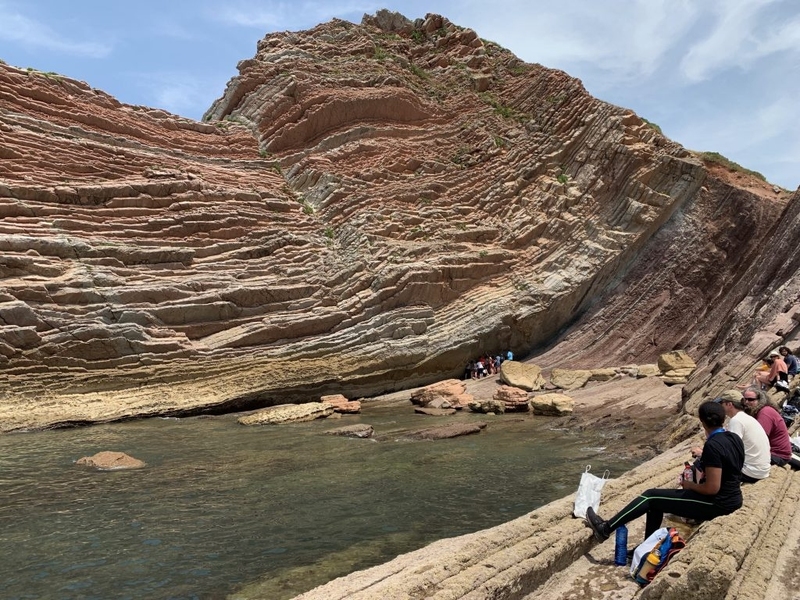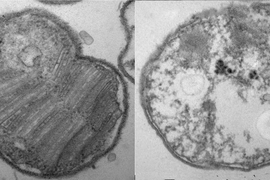Nestled within sediments that accumulate in marine environments, fossil molecules sneakily record how climates and environments change over time. These fossils, vestiges of microbial membranes, preserve different chemical structures that reflect the changing world around them at the time the organisms lived. For almost two decades, scientists have used one class of these molecular fossils, known as glycerol dibiphytanyl glycerol tetraether lipids or GDGTs, to reconstruct climate trends experienced over both regional and local marine environments by examining the number of 5- and 6-carbon-membered rings that formed within the fossil, which are sensitive to the ambient temperatures the microbe experienced. The greater the number of rings in each molecule of fossil lipid, the higher the estimated sea surface temperature.
For almost two decades, scientists estimated ancient sea surface temperatures in this manner by applying a temperature proxy known as TEX86, which enables researchers to relate the relative abundances of fossils and their structures to estimated temperature values to see how climate has changed in the oceans over the past tens of millions of years.
Yet a mystery remained: No one fully understood the mechanisms by which the complex membrane-spanning GDGTs encoded information about temperature through their rings, or which organisms actually contributed to the sedimentary GDGT signals. “Identifying the precise sources of sedimentary lipids has been an enduring problem for geochemists because, without that knowledge, there will always be doubts surrounding their interpretation. The advent of the ‘genomic era’ in molecular biology, however, has opened all sorts of new ways to solve problems like this,” says Roger Summons, the Schlumberger Professor of Geobiology at MIT.
This new approach has now been applied to paleoclimate research, thanks to scientists associated with the MIT Department of Earth, Atmospheric and Planetary Sciences (EAPS).
Former EAPS postdoc Paula Welander, now an associate professor of Earth Systems Science at Stanford University, recently led an effort to understand just how GDGTs are built, as well as how that information relates to the GDGTs produced in the oceans today and, potentially, in the distant past. In a study published last month in PNAS, Welander — along with first-author Zhirui Zeng of Stanford University and colleagues from Stanford, MIT, and the University of Oklahoma — employed a combined organic geochemical, bioinformatic, and microbiological approach to fill in the details on GDGT biosynthesis.
To start, the researchers identified a related type of archaeon, called Sulfolobus acidocaldarius, that produced GDGTs with rings, much like the GDGTs produced by marine organisms. While S. acidocaldarius does not grow in marine environments, a genetically tractable archaeal system is already in place for this model organism — that is, scientists can genetically manipulate it by inserting or deleting genes and seeing how those changes affect its physiology and its membrane lipids. S. acidocaldarius is also well-characterized and grows quickly, enabling researchers to study their manipulations within days, rather than weeks or months.
Within S. acidocaldarius, the researchers found three genes that might code for the enzymes that build rings into the GDGTs, and, deleted them one by one. These mutants showed them that only two of the deletions affected the number of rings present in the GDGTs. When they performed the two deletions together, the GDGTs produced no longer contained any rings. To further confirm the roles the two genes play in ring-building, the researchers expressed the genes in another organism that doesn’t normally produce GDGTs with rings, Methanosarcina acetivorans. Once the genes were expressed, M. acetivorans began to produce GDGTs containing rings.
To study the GDGTs produced, Welander, a microbiologist, turned to Summons and former EAPS postdoc Xiaolei Liu, now assistant professor of organic geochemistry at the University of Oklahoma. Liu, a world-leading expert on identifying GDGTs by mass spectrometry, was not only able to confirm that two genes were needed to make the cyclized GDGT, but also that they operated in a sequential manner. One gene adds rings near the center of the molecule and the second gene subsequently adds more rings to the outer edges.
Summons adds: “This was an exciting collaboration to participate in because earlier work conducted in our laboratory suggested that there may be multiple clades of archaea contributing to the TEX86 signal in the ocean. The new research shows that this does not seem to be the case and that it is just one clade, the marine Thaumarchaeota, that appears responsible, thereby improving the focus for future research directions.”
The study was funded by the Simons Foundation Collaboration on the Origins of Life, the National Science Foundation, and the U.S. Department of Energy.









